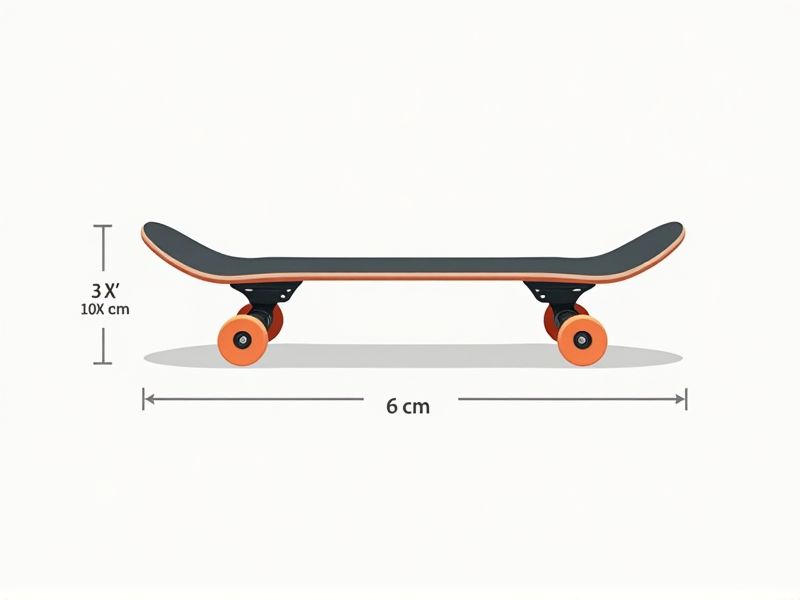
When choosing a skateboard, understanding standard dimensions can help you find the right fit for your style and needs. Most skateboard decks range from 7.5 to 8.5 inches in width, with lengths typically falling between 28 and 33 inches. For example, street skaters often opt for narrower boards (around 7.75 to 8.0 inches wide) for easier tricks, while vert or ramp skaters might prefer wider decks for increased stability. Picking a board that matches your shoe size and preferred riding style ensures better control and comfort.
Deck Width
Deck width is a critical factor when choosing a skateboard, as it directly influences your riding experience and comfort. Standard skateboard decks typically range from 7.5 to 8.5 inches in width, catering to different styles and preferences. A narrower deck, around 7.5 to 8.0 inches, is ideal for technical tricks, while wider decks of 8.0 to 8.5 inches provide better stability for street and vert skating. Ensuring the right deck width not only enhances your performance but also helps you maintain control and balance while skating.
Deck Length
The standard skateboard deck length typically ranges from 28 to 32 inches, catering to various styles of riding and rider preferences. A shorter deck, around 28 to 29 inches, is ideal for street skateboarding, offering increased maneuverability and easier tricks. In contrast, a longer deck, closer to 31 to 32 inches, provides better stability, making it suitable for cruising and downhill riding. When choosing your skateboard, consider how the deck length affects your performance and comfort for your specific skating needs.
Wheelbase
The wheelbase of a skateboard, typically ranging from 14 to 15.5 inches, significantly influences its stability and maneuverability. A longer wheelbase offers enhanced stability and is favored for cruising or downhill riding, while a shorter wheelbase allows for quicker turns and easier tricks, making it ideal for street skating. It's important to match your wheelbase preference with your intended style, as this can affect your overall skating experience and performance. Choosing the right wheelbase helps you optimize your control and comfort while riding.
Wheel Diameter
When choosing a skateboard, the wheel diameter is a crucial specification that affects performance and ride quality. Standard skateboard wheels typically range from 50mm to 60mm in diameter, with smaller wheels, around 50-54mm, being ideal for technical tricks and street skating due to their agility. Mid-range wheels, between 54mm and 56mm, offer a balance between stability and trick performance, making them a popular choice for beginners. Larger wheels, around 58-60mm, are best suited for cruising and downhill riding, providing better speed and shock absorption over rough terrain.
Wheel Hardness
Wheel hardness, measured in durometer, significantly impacts your skating experience, with common ratings ranging from 78A to 101A. Softer wheels (78A-87A) provide better grip and shock absorption, making them ideal for cruising or rough terrain. On the other hand, harder wheels (88A-101A) offer reduced friction and quicker slides, perfect for street and park skating. Choosing the right wheel hardness ensures optimal performance, enhancing your overall skating experience.
Truck Width
Truck width is a crucial factor influencing skateboard performance, with standard widths typically ranging from 129mm to 150mm. A truck width that matches your deck width ensures better balance, stability, and maneuverability, enabling riders to execute tricks with precision. For decks measuring 7.5 to 8 inches wide, a truck width of 129mm to 139mm is recommended, while wider decks, 8.25 inches and up, benefit from 148mm to 150mm trucks. Adjusting that parameter can significantly enhance your skating experience, providing the right balance between responsiveness and control.
Truck Height
Truck height is a critical factor in skateboard performance, directly influencing your ride experience. Standard truck heights range from 48mm to 55mm, with lower trucks providing better stability and increased control for street skating. In contrast, higher trucks, typically around 52mm to 58mm, offer enhanced clearance for tricks involving ollies and grinds, making them ideal for transition and vert skating. Understanding your specific needs can help you select the right truck height, ultimately improving your overall skateboarding skills.
Deck Concave
The deck concave of a skateboard significantly affects your riding experience, influencing both control and stability. Decks typically feature three primary concave shapes: shallow, medium, and deep, with the deep concave offering maximum responsiveness for technical tricks. A typical skateboard deck measures about 31 inches in length and 8 inches in width, allowing for diverse shapes tailored to different riding styles. Your choice of concave can enhance your performance, especially if you prefer street skating or vert ramps.
Nose And Tail Length
The standard skateboard typically features a nose length of around 6 to 7 inches and a tail length of approximately 6 to 7 inches, providing a balanced design for tricks and stability. This symmetrical shape, with an average deck width of 7.5 to 8.5 inches, allows for greater maneuverability on various terrains. When selecting a skateboard, consider that the nose is slightly wider to facilitate tricks like shove-its and kickflips. A shorter tail enhances pop and control, vital for executing advanced skateboarding techniques.
Material And Construction
Skateboards typically consist of a deck, trucks, wheels, and bearings, each of which plays a crucial role in overall performance. The deck is commonly made from 7-ply maple wood, providing durability and resilience, while some options utilize bamboo or fiberglass for added flexibility. Trucks, usually crafted from aluminum or magnesium, weigh around 1 to 2 pounds, influencing the skateboard's turning and stability. For optimal performance, look for high-quality urethane wheels with a durometer rating between 78A and 101A, ensuring a smooth ride and sufficient grip on various surfaces.
